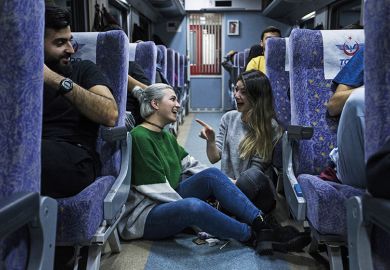US universities that seek the benefits of study-abroad programmes without the forbidding costs are increasingly turning to “virtual” foreign exchanges involving individual students and entire classrooms.
Although the underlying idea is not new, improvements in technology and a growing recognition of the value of virtual exchanges have fuelled adoption across US campuses in just the past year or two.
“The seeds that have been planted are starting to come up,” said Mohamed Abdel-Kader, executive director of the federally sponsored Stevens Initiative, an early promoter of virtual exchanges.
The believers include Rachel Gallery, an associate professor at the University of Arizona who tried it out this past autumn on the second- and third-years in her natural resource ecology class.
For her initial test, Dr Gallery offered the 100-student class the option of an additional four meetings – albeit at 7.30am – to match the availability of a similar environment studies class in Egypt.
“I was a little bit sceptical” about whether any students would show up at that hour, or find it worthwhile, Dr Gallery said. About 15 did, and right from the start, they eagerly shared with their Egyptian classmates both coursework and personal stories.
“The very first meeting, I was just proven completely wrong,” she said.
Students on the other end of the video screen also benefited, both academically and socially, said their instructor, Arthur Bos, an associate professor of marine biology and ecology at the American University in Cairo.
“I would love to incorporate similar sessions to future classes,” Dr Bos said.
Faculty are now reaching similar conclusions around the US, said Mr Abdel-Kader, who served in the US Department of Education in the Obama administration. For several years, the Stevens Initiative often stood alone at educational conferences as it explained the idea. In recent months, however, it has found itself joined by early adopters such as Arizona, the University of Michigan, and Clemson and DePaul universities; and by organisations that help connect classes and students abroad, such as Soliya and NaTakallam.
“It is getting past the niche stage,” said one organiser, Nathan Rahu-Bieri, a senior programme administrator at Michigan’s William Davidson Institute. “There’s a lot of momentum around it.”
Yet with the idea still relatively new, advocates are still working out key details, such as what types of curriculum to use and who writes it, whether interactions should occur during credit-bearing offerings or on voluntary terms, whether international video collaborations work best between full classrooms or individual students, and how to coordinate connections across multiple time zones.
Dr Gallery created her own virtual classroom exchange back in 2014, when she and a colleague at Western Michigan University wanted to bring their classes together. When Arizona asked her to try an international version this past autumn, she had less hope, given the proposed hour of the day and the lack of academic reward for any students who agreed to take part.
But the 15 volunteers joined eagerly, having little ability to afford an actual foreign exchange, Dr Gallery said. “They viewed this as a virtual semester-abroad programme, and they were psyched about it,” she said. “They were really engaged from day one.”
Register to continue
Why register?
- Registration is free and only takes a moment
- Once registered, you can read 3 articles a month
- Sign up for our newsletter
Subscribe
Or subscribe for unlimited access to:
- Unlimited access to news, views, insights & reviews
- Digital editions
- Digital access to THE’s university and college rankings analysis
Already registered or a current subscriber?










